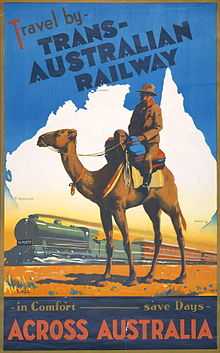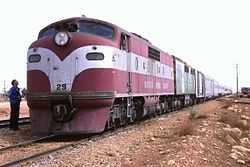Trans-Australian Railway
|
Trans-Australian Railway
Legend
  1930s advertising poster for the Trans-Australian Railway. | ||||||||||||||||||||||||||||||||||||||||||||||||||||||||||||||||||||||||||||||||||||||||||||||||||||||||||||||||||||||||||||||||||||||||||||||||||||||||||||||||||||||||||||||||||||||||||||||||||||||||||||||||||||||||||||||||||||||||||||||||||||||||||||
The Trans-Australian Railway crosses the Nullarbor Plain of Australia from Port Augusta in South Australia to Kalgoorlie in Western Australia. It includes the world's longest stretch of dead-straight railway track, a 478 kilometre (297 mi) length between the 797 km post west of Ooldea and the 1275 km post west of Loongana.
The line forms an important freight route between Western Australia and the eastern states. Currently two passenger services also use the line, the Indian Pacific for its entire length and The Ghan between Port Augusta and Tarcoola.
Earlier passenger services on the route were known as the Trans-Australian or, commonly, just 'The Trans'.
History
In 1901, the six Australian colonies federated to form the Commonwealth of Australia. At that time, Perth, the capital of Western Australia, was isolated from the remaining Australian States by thousands of kilometres of desert terrain and the only practicable method of transport was by sea, a time-consuming, inconvenient and often uncomfortable voyage across the Great Australian Bight, a stretch of water known for rough seas. One of the inducements held out to Western Australians to join the new federation was the promise of a federally funded railway line linking Western Australia with the rest of the continent.
In 1907 legislation was passed, allowing for the route to be surveyed.
The survey was completed in 1909 and proposed a route from Port Augusta (the existing railhead at the head of Spencer Gulf in South Australia's wheatfields) via Tarcoola to the gold mining centre of Kalgoorlie in Western Australia, a distance of 1063 miles (1711 km). The line was to be to the standard gauge of 4 ft 8 1⁄2 in (1,435 mm) even though, at the time, the state railway systems at both ends were narrow gauge. It was costed at £4,045,000.
Legislation authorising the construction was passed in December 1911 by the Andrew Fisher Labor government and Commonwealth Railways was established in 1912 to build the line. Work commenced in September 1912 in Port Augusta.
Work proceeded eastwards from Kalgoorlie and westwards from Port Augusta through the years of the First World War. By 1915 the two ends of the line were just over 600 miles (966 km) apart with materials being delivered daily.[1] Construction progressed steadily as the line was extended through dry and desolate regions until the two halves of the line met on 17 October 1917.[2]
The entire intercity route was not converted to standard gauge until 1970.
Named services
On inauguration, the passenger service was known as the Trans-Australian Express.[3] Towards the end of its life as a passenger service between Kalgoorlie and Port Augusta it was usually known as the Trans-Australian. It operated as a dual service, with the service known as the Indian Pacific from 1970 until 1991.
From the start of construction until 1996 the Tea and Sugar Train carried vital supplies to the isolated work sites and towns along the route.
Terrain
The final distance was 1051.73 miles (1692.60 km), slightly less than the original survey. At no point along the route does the line cross a permanent fresh watercourse.
Bores and reservoirs were established at intervals, but the water was often brackish and unsuitable for steam locomotive use, let alone human consumption, so water supplies had to be carried on the train.
In the days of steam locomotion, about half the total load was water for the engine.
Names of stopping places
Most of the stopping locations in the 129° E to 134° E part of the railway in South Australia (except for Deakin, which is 3 km inside Western Australia's state border) were named after the first seven Australian Prime Ministers:-
| Location | Name of Prime Minister | Prime minister number | Distance from Port Augusta in miles [4] |
|---|---|---|---|
| Deakin, Western Australia | Alfred Deakin | Second | 599 |
| Hughes, South Australia | Billy Hughes | Seventh | 567 |
| Cook, South Australia | Joseph Cook | Sixth | 513 |
| Fisher, South Australia | Andrew Fisher | Fifth | 479 |
| Reid, Western Australia | George Reid | Fourth | 460 |
| Watson, South Australia | Chris Watson | Third | 445 |
| Barton, South Australia | Edmund Barton | First | 376 |
Other federal ministers from the 1900-1917 era do occur outside of this sequence, amongst stopping places on the rail route. Curtin and Chifley are much closer to Kalgoorlie while O'Malley and Lyons are on the South Australian side.
Operations

Because of the inevitable problems of finding suitable water for steam locomotives in a desert, the original engineer, Henry Deane envisaged diesel locomotives for the line. He got as far as making enquiries with potential manufacturers. Unfortunately, a scandal involving the supply of sleepers led to Deane's resignation before the diesel locomotive proposal had advanced beyond the point of no return.[5]
Initially the train was hauled by G class locomotives (similar to the New South Wales 32 class) and from 1938 by C class locomotives (similar to the New South Wales 36 class).[6] It was not until 1951 that regular diesel hauled passenger services worked on the Trans Australia Railway, hauled by the new GM class locomotives.[7]
The Trans-Australian Railway originally had crossing loops (passing sidings) 400 m long every 100 km or so. As traffic increased the number of crossing loops increased. To handle longer trains, crossing loops were lengthened so that in 2008 they are all at least 1800 m long and spaced about 30 km to 60 km apart.
Most crossing loops are unattended and train crew operate the points as required. Crossing loops now have self restoring points, so that points are reset to the straight route when a train departs from a crossing loop. The loops are now being fitted with radio controls so that train crew can set the points as they approach. The safeworking is Train Orders.
See also
References
Notes
- ↑ "The Federal line". The West Australian (Perth, Western Australia: National Library of Australia). 16 April 1915. p. 6. Retrieved 16 October 2013.
- ↑ The Golden Jubilee of the Trans Australian Railway Chambers, T.F. Australian Railway Historical Society Bulletin November, 1968 pp267-275
- ↑ Gillman, B. H (July 1982), "Linking East and West: a trip with the first Trans Australian Express. - Reprinted from the S. A. R. Officers' Magazine, Nov/ Dec 1919-", Bulletin (Australian Railway Historical Society) 33 (July 1982): 137–147, ISSN 0005-0105
- ↑ (1927) Travel in comfort across Australia on the Trans-Australian Railway. Melbourne : Commonwealth Railways. internal map titled Map shewing Connections between Capital Cities via Trans- Australian Railway
- ↑ Burke, A 1991., Rails through the Wilderness; New South Wales University Press
- ↑ Oberg, Leon (1984). Locomotives of Australia 1850's - 1980's. Frenchs Forest: Reed Books. pp. 122, 164. ISBN 0 730100 05 7.
- ↑ New Train Service Across Australia The West Australian 12 November 1951
Bibliography
- Adam-Smith, Patsy (1974) The desert railway Adelaide : Rigby ISBN 0-85179-675-3
- Avery, Rod (2006). Freight Across the Nation: The Australian Superfreighter Experience. Brisbane: Copyright Publishing Co. ISBN 1876344474.
- Buckland, J.L. (1965) Canadian and American Locomotives in Wartime Service on the Trans-Australian Railway Australian Railway Historical Society Bulletin, September, 1965
- Burke, David, (1991) Road through the wilderness : the story of the transcontinental railway, the first great work of Australia’s federation Kensington, N.S.W. : New South Wales University Press. ISBN 0-86840-140-4
- Henshaw, C.H. (1964) Overland to Perth in 1928 Australian Railway Historical Society Bulletin, April, 1964
- Spear, R. Clarke (1917) The Golden west : Trans-Australian Christmas numberPerth, Western Australia "The Golden west, Vol. 13, December 1917."
External links
| |||||||||||

